Navigating budget travel can sometimes lead to creative solutions, especially when your preferred ultra low-cost carrier (ULCC) doesn’t directly serve your final destination. Recently, while traveling from Los Angeles, I encountered this exact scenario when trying to return home to Seattle, Washington. Allegiant Air, known for its rock-bottom fares, doesn’t actually fly into Seattle-Tacoma International Airport (SEA) or the surrounding Seattle metropolitan area. However, my desire to experience Allegiant’s service led me to find an interesting workaround involving a flight to Eugene, Oregon, and a connecting flight with Delta to Seattle.
The allure of a shockingly low base fare of just $10 on Allegiant was hard to ignore. Even after mandatory fees and taxes, the total cost for the Allegiant leg of the journey was a mere $44. Coupled with a connecting Delta flight to Seattle, the entire trip still promised significant savings of $50-60 compared to a nonstop flight, plus the novelty of trying a new airline. Adventure and savings? I was definitely intrigued.
Understanding Allegiant’s Ultra Low-Cost Model
Allegiant Air operates as an ultra low-cost carrier, which means they unbundle everything. From seat selection and baggage allowance to onboard refreshments and even carry-on bags, nearly every aspect of your journey comes with an additional price tag. This pricing strategy can make the initial booking process on their website somewhat complex.
Upon starting the booking, Allegiant immediately presents you with various bundle options, each offering a different combination of services at escalating prices. It’s crucial to take your time and carefully calculate what you truly need versus what is simply offered in a bundle. Sometimes, the pre-packaged bundles may not offer the best value compared to selecting services à la carte.
For my trip, checking a bag was essential. The cheapest bundle that included a checked bag added a substantial $100 to the base fare. This bundle included perks I didn’t require, such as priority boarding, premium seat selection, and ticket change flexibility.
Instead, I opted to build my own personalized bundle. I selected a seat for $9, a carry-on bag (yes, Allegiant charges for anything larger than a personal item that fits under the seat) for $29, and a checked bag for $28. This à la carte approach saved me $34, bringing my total out-of-pocket cost for the Allegiant portion to $110.
It’s also worth noting Allegiant’s dynamic pricing strategy. The cost of add-ons increases after the initial booking. The same selection of seat and baggage would have jumped by 57% if added just minutes after booking the ticket. Adding these at the airport would have resulted in a 75% price increase. This highlights the importance of planning and pre-purchasing any extras you anticipate needing.
My Allegiant Flight Experience: LAX to Eugene
The flight itself was largely unremarkable, which is often a positive aspect of budget travel – uneventful and on-time. Allegiant’s check-in process is primarily online, either through their mobile app or website, with free options available. I opted for the website check-in and printed my boarding pass at the hotel to avoid any potential fees. If you prefer a printed boarding pass at the airport, Allegiant charges $5 for this service.
Bag drop at Los Angeles International Airport (LAX) in the newly renovated Terminal 1 was efficient. The line was short, and my checked bag was quickly processed after scanning my mobile boarding pass.
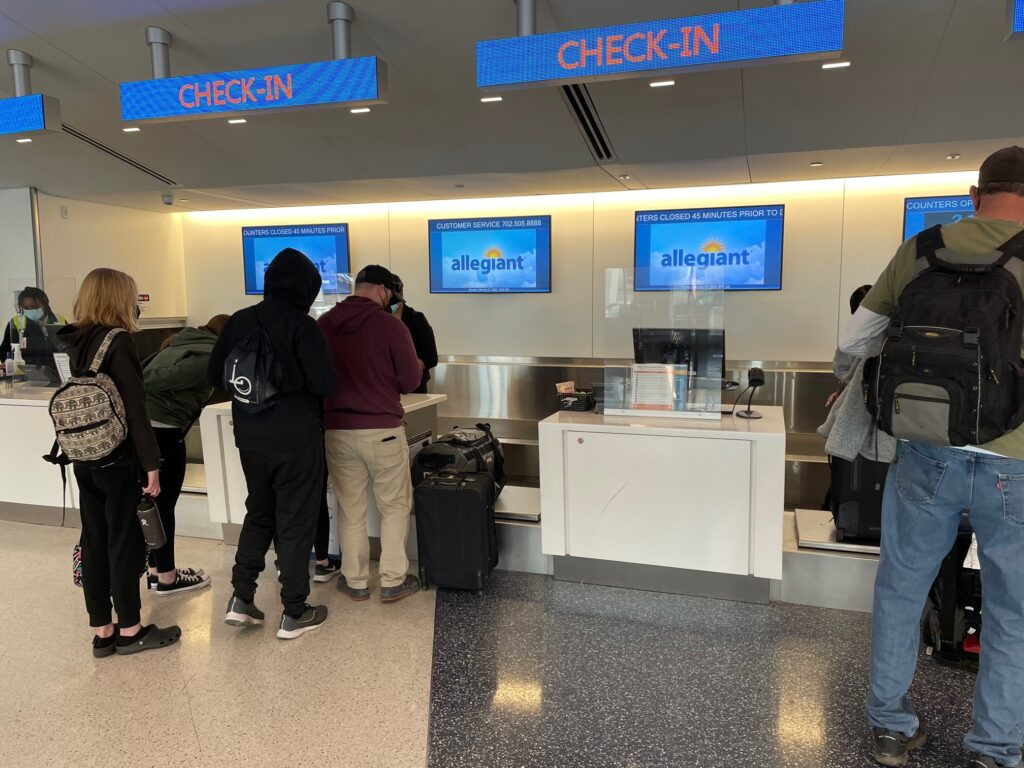 Allegiant check-in at LAX. Passengers are queuing to check in for their Allegiant flights at Los Angeles International Airport.
Allegiant check-in at LAX. Passengers are queuing to check in for their Allegiant flights at Los Angeles International Airport.
While Allegiant operates from Terminal 1 at LAX, the departure gates are located in the Tom Bradley International Terminal, a considerable distance away. Reaching these gates requires a post-security bus ride and a further 10-minute walk to the end of the terminal pier. While the airside views from the bus and the modern international terminal are impressive, this transit added a significant 30 minutes to the curb-to-gate time. This experience highlighted the importance of allowing ample time, especially at large airports like LAX, even when flying domestically.
Boarding commenced on time, preceded by a lengthy list of pre-boarding groups, including military personnel, families with young children, frequent flyers, and Allegiant credit card holders who had the card physically present. Boarding zones followed, and I boarded in zone two, settling into seat 24A towards the rear of the Airbus A319.
 Allegiant Airbus A319 parked at the gate, as seen from the airport terminal window.
Allegiant Airbus A319 parked at the gate, as seen from the airport terminal window.
The cabin of the Airbus A319 featured an all-economy 3-3 seating configuration. The interior was functional but basic, with blue pleather seat covers over slim, fixed-back seats. The gray thermoplastic seatbacks presented a rather utilitarian aesthetic.
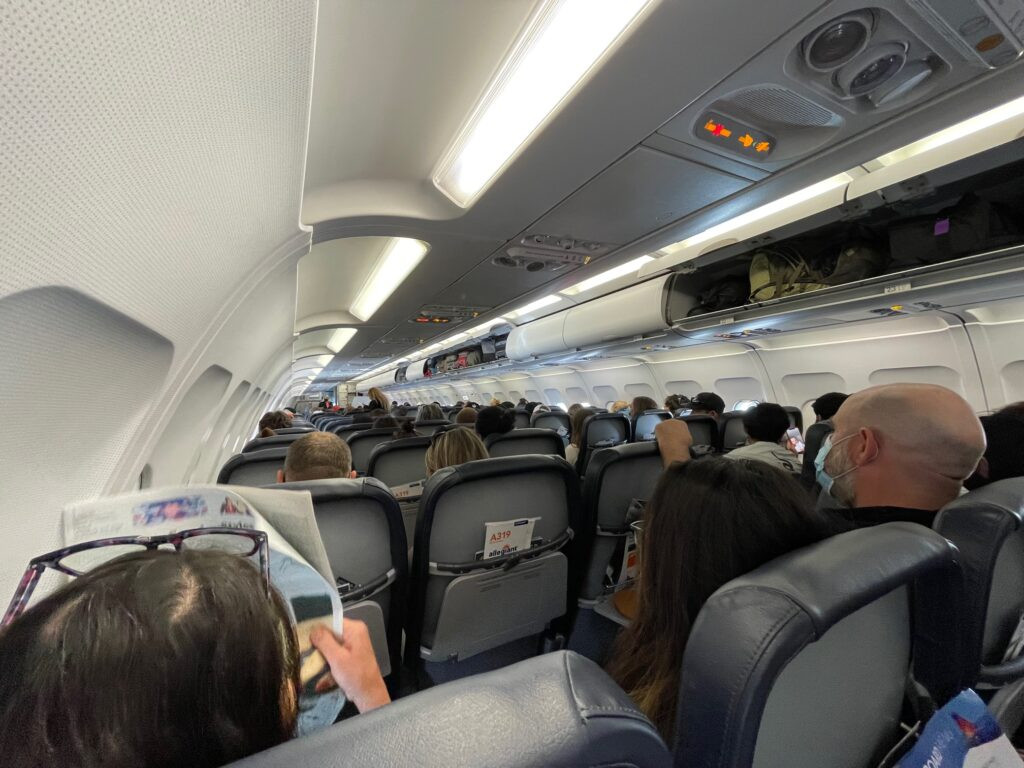 Interior view of an Allegiant Airbus A319 cabin filled with passengers, showcasing rows of gray seatbacks.
Interior view of an Allegiant Airbus A319 cabin filled with passengers, showcasing rows of gray seatbacks.
While the seat comfort was not exceptional, the 30-inch seat pitch was noticeably better than some competing ULCCs, offering slightly more legroom.
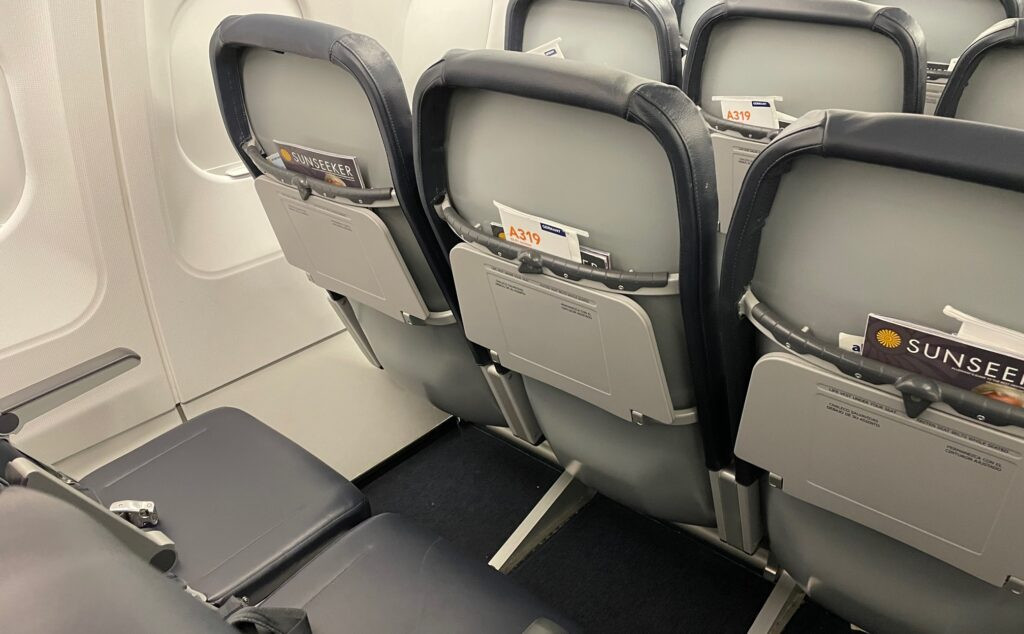 Allegiant A319 cabin showing blue seat covers on slim seats and gray seatbacks, highlighting the basic interior.
Allegiant A319 cabin showing blue seat covers on slim seats and gray seatbacks, highlighting the basic interior.
Each seatback included a fold-up tray table and a small literature pocket containing the airline’s in-flight magazine (a pleasant surprise!), a safety card, and a credit card application. Space was limited, but sufficient for essential items like a phone.
 Close-up of a literature pocket on an aircraft seatback, containing an A319 safety card and Sunseeker in-flight magazine.
Close-up of a literature pocket on an aircraft seatback, containing an A319 safety card and Sunseeker in-flight magazine.
The flight departed on schedule, offering views of Los Angeles beaches before heading towards Oregon. About 30 minutes into the flight, flight attendants offered buy-on-board food and beverage service. Allegiant provides a variety of options for purchase, from snacks to cocktails and even wine selections.
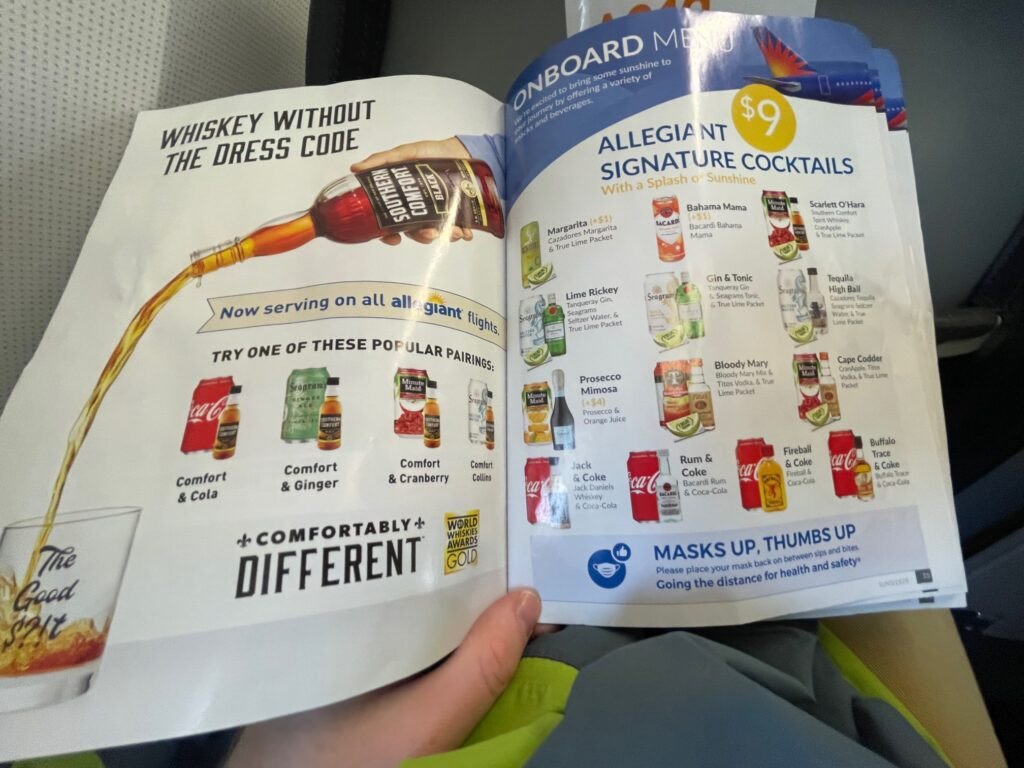 Allegiant's buy-on-board menu showcasing beverage options available for purchase during the flight.
Allegiant's buy-on-board menu showcasing beverage options available for purchase during the flight.
Allegiant’s in-flight magazine featured an extensive selection of alcoholic beverages, reflecting the airline’s connections to destinations like Las Vegas. However, I opted to skip the onboard service, as Allegiant flights lack in-flight entertainment, Wi-Fi, and in-seat power. Realizing I had forgotten my portable charger, I decided to take a nap instead.
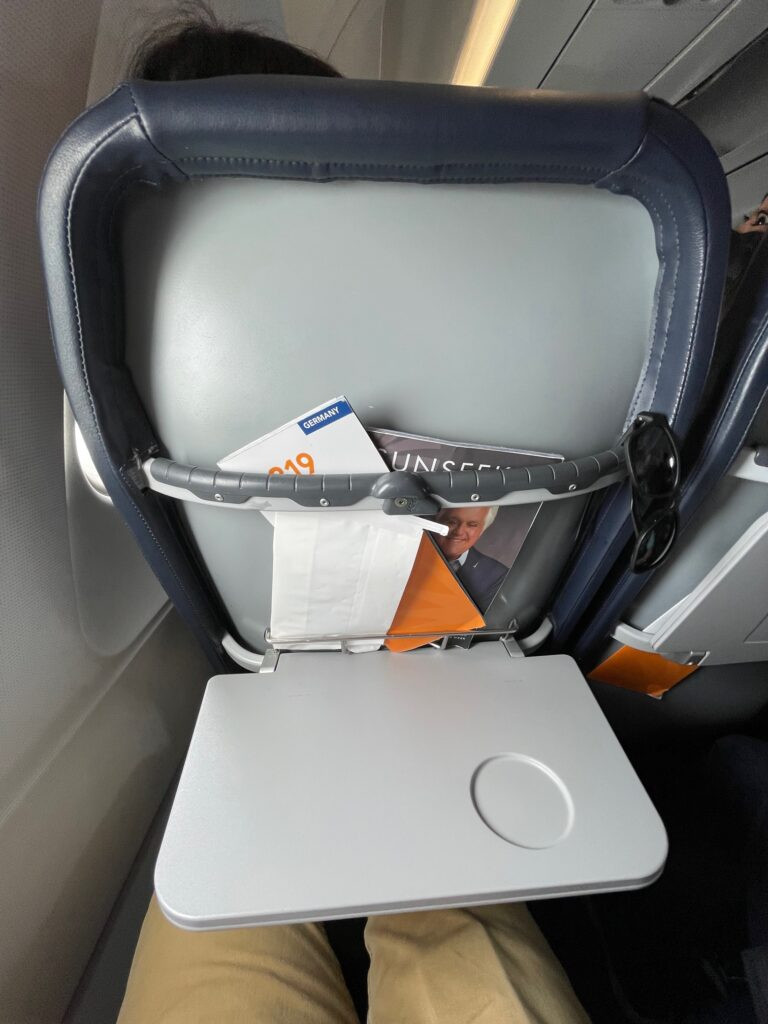 Tray table open on an aircraft seat, showing the literature pocket with a safety card and in-flight magazine.
Tray table open on an aircraft seat, showing the literature pocket with a safety card and in-flight magazine.
Arrival in Eugene and Connecting to Seattle
The flight landed in Eugene after approximately 90 minutes, followed by a reasonable 24-minute wait for baggage delivery. From Eugene, I connected with Delta for the final leg to Seattle.
While Allegiant Air doesn’t directly fly to Seattle, this experience demonstrates a potential budget travel strategy. By flying to a nearby airport like Eugene and utilizing connecting flights, travelers can potentially access Allegiant’s low fares while still reaching their ultimate destination of Seattle. It’s essential to weigh the pros and cons, considering factors such as connection times, potential layover inconveniences, and the overall journey duration.
Why Doesn’t Allegiant Fly Directly to Seattle?
Several factors likely contribute to Allegiant Air not serving Seattle directly. Seattle-Tacoma International Airport (SEA) is a major international hub and one of the busiest airports in the Pacific Northwest. Operating costs at such a large airport, including landing fees and gate charges, can be higher compared to smaller regional airports.
Additionally, the Seattle market is highly competitive, with established carriers offering numerous nonstop and connecting flights. Allegiant’s business model typically focuses on underserved markets and leisure destinations, often utilizing smaller, less congested airports. They may find it more profitable to serve airports in the vicinity of major cities rather than directly competing in saturated markets like Seattle.
Exploring Alternative Airports Near Seattle Served by Allegiant
While Allegiant doesn’t fly to Seattle-Tacoma International Airport, they do serve other airports in the Pacific Northwest region that could be considered alternatives for travelers heading to Seattle. For example, Bellingham International Airport (BLI) in Washington state is located approximately 90 miles north of Seattle and is served by Allegiant Air. Flying into Bellingham and then traveling south to Seattle could be another potential option for budget-conscious travelers willing to consider ground transportation for part of their journey.
Conclusion: Weighing Budget vs. Convenience for Seattle Travel
So, Does Allegiant Fly To Seattle directly? No. However, as demonstrated by this experience, resourceful travelers can leverage Allegiant’s ultra-low fares by flying to nearby airports and utilizing connecting flights or ground transportation to reach Seattle. While this approach can offer significant cost savings, it’s crucial to carefully consider the trade-offs in terms of time, convenience, and potential additional travel expenses. For those prioritizing budget above all else and willing to embrace a more adventurous travel itinerary, flying Allegiant to a nearby airport and connecting to Seattle can be a viable option. Just remember to factor in all potential fees and carefully compare the overall cost and travel time against other airlines serving Seattle directly to make the most informed decision for your travel needs.
All images credited to the author, Jeremy Dwyer-Lindgren